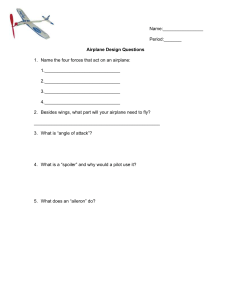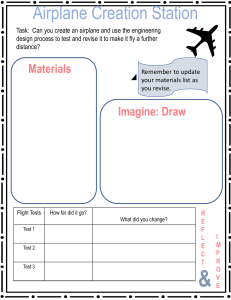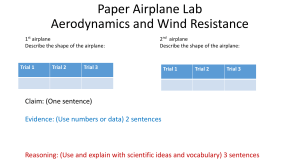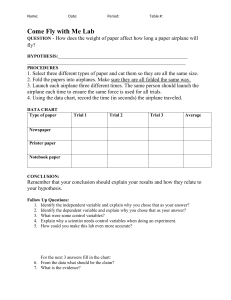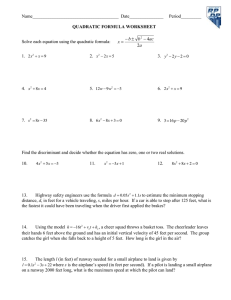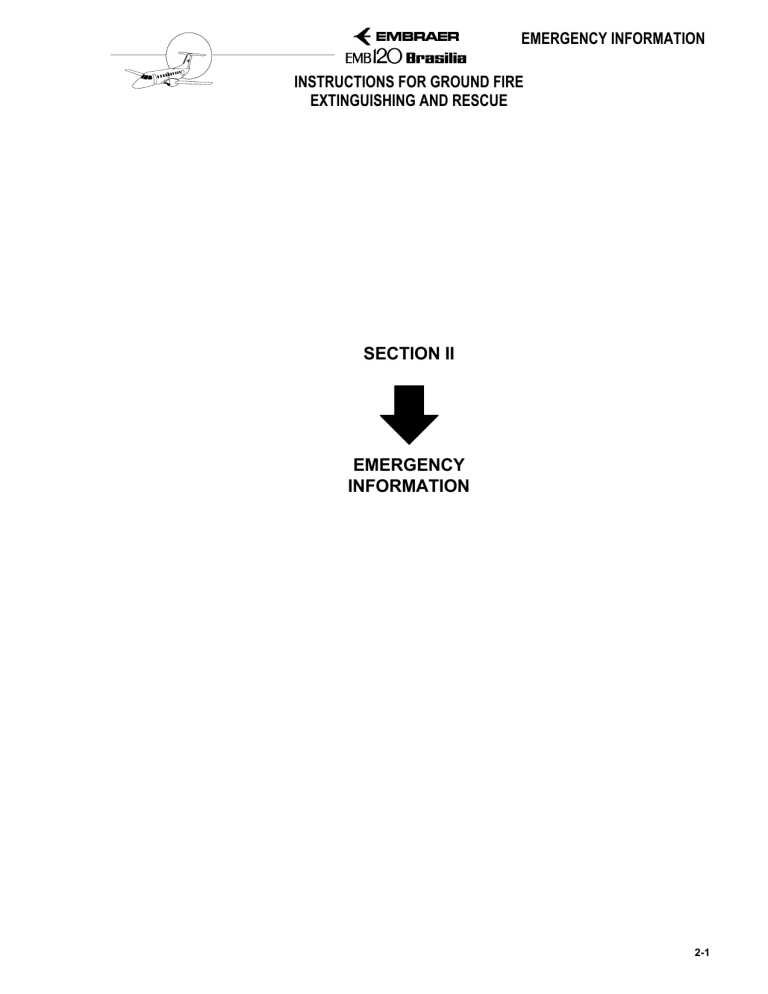
#########(0(5*(1&<#,1)250$7,21 ,16758&7,216#)25#*5281'#),5( (;7,1*8,6+,1*#$1'#5(6&8( SECTION II ª EMERGENCY INFORMATION 2-1 (0(5*(1&<#,1)250$7,21 ,16758&7,216#)25#*5281'#),5( (;7,1*8,6+,1*#$1'#5(6&8( Figure 2-1. Interior Arrangement - Passenger Configuration 1 2-2 REVISION 2 #########(0(5*(1&<#,1)250$7,21 ,16758&7,216#)25#*5281'#),5( (;7,1*8,6+,1*#$1'#5(6&8( Figure 2-1A. Interior Arrangement - Passenger Configuration 2 REVISION 2 2-2A (0(5*(1&<#,1)250$7,21 ,16758&7,216#)25#*5281'#),5( (;7,1*8,6+,1*#$1'#5(6&8( Figure 2-1B. Interior Arrangement - Passenger Configuration 3 2-2B REVISION 2 #########(0(5*(1&<#,1)250$7,21 ,16758&7,216#)25#*5281'#),5( (;7,1*8,6+,1*#$1'#5(6&8( Figure 2-1C. Interior Arrangement - Passenger/Full Cargo Configuration 4 REVISION 5 2-2C/2-2D blank) #########(0(5*(1&<#,1)250$7,21 ,16758&7,216#)25#*5281'#),5( (;7,1*8,6+,1*#$1'#5(6&8( Figure 2-2. Location of Composite Materials on Airplane Skin REVISION 2 2-3 (0(5*(1&<#,1)250$7,21 ,16758&7,216#)25#*5281'#),5( (;7,1*8,6+,1*#$1'#5(6&8( Figure 2-3. Danger Areas 2-4 EMERGENCY INFORMATION INSTRUCTIONS FOR GROUND FIRE EXTINGUISHING AND RESCUE SECTION II EMERGENCY INFORMATION 2-1. FLAMMABLE AND/OR EXPLOSIVE COMPONENTS, AND FLUIDS, AND EMERGENCY EQUIPMENT 2-2. GENERAL Figure 2-4 highlights the location of flammable or explosive components, equipment and fluids, as well as the location of emergency equipment of the several airplane interior arrangement configuration. The following paragraphs provide a brief description of these items. 2-3. FUEL Fuel is stored in two integral wing tanks. Fuel supply lines extend through the nacelles to the engines. In the airplanes provided with APU, the lines extend from the wing roots as far as the tail cone. Total fuel capacity is 3310 liters (824 U.S. Gal). Fuel used: jet fuel, specification ASTM D1655. 2-4. ENGINE OIL The oil used for engine lubrication is stored in an integral tank in each engine. The capacity of each tank is approximately 9 liters (2,5 U.S. Gal). The oil specification is MIL-L-23699A, Type II. 2-5. WHEELS The airplane landing gear wheels are made of forged aluminum alloy. Each main landing wheel is provided with three fusible plugs, which deflate the tire if overtemperature occurs. 2-6. HYDRAULIC ACCUMULATORS The parking/emergency brake accumulator is pressurized to 1100 psi at 21°C and is located at the left wing-to-fuselage attachment. The landing gear/passenger/crew entry door accumulator is pressurized to 1500 psi at 21°C and is located in the hydraulic compartment, in the aircraft nose. The specification of the nitrogen used is BB-411, Type I, Class I, Grade B. 2-7. OXYGEN CYLINDERS (FIXED) The oxygen supply (1850 psi) is stored in a cylinder whose volume capacity is 115 cu.ft for crew and passengers supply. For aircraft equipped with chemical oxygen generation system for passengers, the cylinder for crew supply has a capacity of 40 cu.ft. The specification of the oxygen used is MIL-O-27210. REVISION 2 2-5 EMERGENCY INFORMATION INSTRUCTIONS FOR GROUND FIRE EXTINGUISHING AND RESCUE 2-8. BATTERY The airplane main battery is located on the left side of the nose section. It is a nickel-cadmium battery and its capacity is 24 V DC - 36 AMP/hour. 2-9. HYDRAULIC RESERVOIRS The hydraulic reservoirs are located aft of the engine nacelles. Each has a volume capacity of 4.2 liters (1.1 U.S. Gal) of hydraulic fluid, specification MIL-H-5606. They are pressurized to 30 ± 1 psi with engine bleed air. 2-10. PORTABLE OXYGEN CYLINDERS The oxygen cylinders, specification DOT-3AA-1800, are equipped with free-flow masks and have a capacity of 11 cu.ft when charged to 1800 psi at 21°C. 2-11. PORTABLE FIRE EXTINGUISHERS The portable fire extinguishers are charged with 2.5 lb of HALON 1211 (CBr C1F2) gaseous agent or 2.2 lb of HALONITE. Only the HALONITE (HALON 1211 and HALON 1301) fire extinguishers are disposable. Both fire extinguishers are applicable to all types of fire (classes A, B, and C). 2-12. OTHER EQUIPMENT As emergency equipment, the following are applied: a hatchet for cutting operations, ropes flashlight, first-aid Kit, full face mask and smoke goggles and a medicinal Kit (optional). RESCUE PERSONNEL SHALL NOT CUT THE BREAK-IN AREAS REACHED BY FUEL SPILLAGE. Break-in areas require metal-cutting portable equipment, such as hydromechanical pliers or similar tools. In an emergency, if the need arises to cut out an opening in the fuselage, the rescue crew shall do it at the break-in area. The break-in areas are located clear of electrical harness, hydraulic piping or machined frames so as to facilitate the rescue. 2-6 REVISION 8 #########(0(5*(1&<#,1)250$7,21 ,16758&7,216#)25#*5281'#),5( (;7,1*8,6+,1*#$1'#5(6&8( Figure 2-4. Location of Flammable and Explosive Components and Fluids (Sheet 1) REVISION 3 2-7 (0(5*(1&<#,1)250$7,21 ,16758&7,216#)25#*5281'#),5( (;7,1*8,6+,1*#$1'#5(6&8( Figure 2-4. Location of Flammable and Explosive Components and Fluids (Sheet 2) 2-8 REVISION 3 #########(0(5*(1&<#,1)250$7,21 ,16758&7,216#)25#*5281'#),5( (;7,1*8,6+,1*#$1'#5(6&8( Figure 2-4A. Emergency Equipment Location - Configuration 1 (Sheet 1) REVISION 5 2-8A-1 (0(5*(1&<#,1)250$7,21 ,16758&7,216#)25#*5281'#),5( (;7,1*8,6+,1*#$1'#5(6&8( Figure 2-4A. Emergency Equipment Location - Configuration 1 (Sheet 2) 2-8A-2 REVISION 5 EMERGENCY INFORMATION INSTRUCTIONS FOR GROUND FIRE EXTINGUISHING AND RESCUE Figure 2-4B. Emergency Equipment Location - Configuration 2 (Sheet 1) REVISION 5 2-8B-1 EMERGENCY INFORMATION INSTRUCTIONS FOR GROUND FIRE EXTINGUISHING AND RESCUE Figure 2-4B. Emergency Equipment Location - Configuration 2 (Sheet 2) 2-8B-2 REVISION 5 EMERGENCY INFORMATION INSTRUCTIONS FOR GROUND FIRE EXTINGUISHING AND RESCUE Figure 2-4B. Emergency Equipment Location - Configuration 2 (Sheet 3) REVISION 5 2-8B-3 EMERGENCY INFORMATION INSTRUCTIONS FOR GROUND FIRE EXTINGUISHING AND RESCUE Figure 2-4B. Emergency Equipment Location - Configuration 2 (Sheet 4) 2-8B-4 REVISION 5 EMERGENCY INFORMATION INSTRUCTIONS FOR GROUND FIRE EXTINGUISHING AND RESCUE Figure 2-4C. Emergency Equipment Location - Configuration 3 (Sheet 1) REVISION 5 2-8C-1 EMERGENCY INFORMATION INSTRUCTIONS FOR GROUND FIRE EXTINGUISHING AND RESCUE Figure 2-4C. Emergency Equipment Location - Configuration 3 (Sheet 2) 2-8C-2 REVISION 5 EMERGENCY INFORMATION INSTRUCTIONS FOR GROUND FIRE EXTINGUISHING AND RESCUE Figure 2-4C. Emergency Equipment Location - Configuration 3 (Sheet 3) REVISION 5 2-8C-3 EMERGENCY INFORMATION INSTRUCTIONS FOR GROUND FIRE EXTINGUISHING AND RESCUE Figure 2-4C. Emergency Equipment Location - Configuration 3 (Sheet 4) 2-8C-4 REVISION 5 #########(0(5*(1&<#,1)250$7,21 ,16758&7,216#)25#*5281'#),5( (;7,1*8,6+,1*#$1'#5(6&8( Figure 2-4D. Emergency Equipment Location - Configuration 4 REVISION 5 2-8D-1/(2-8D-2 blank) EMERGENCY INFORMATION INSTRUCTIONS FOR GROUND FIRE EXTINGUISHING AND RESCUE Figure 2-5. Emergency Exit-Left Side REVISION 1 2-9 EMERGENCY INFORMATION INSTRUCTIONS FOR GROUND FIRE EXTINGUISHING AND RESCUE Figure 2-6. Emergency Exit-Right Side 2-10 REVISION 1 EMERGENCY INFORMATION INSTRUCTIONS FOR GROUND FIRE EXTINGUISHING AND RESCUE Figure 2-7. Break-in Areas REVISION 8 2-11 EMERGENCY INFORMATION INSTRUCTIONS FOR GROUND FIRE EXTINGUISHING AND RESCUE Figure 2-8. Emergency Exit for Pilots 2-12 EMERGENCY INFORMATION INSTRUCTIONS FOR GROUND FIRE EXTINGUISHING AND RESCUE Figure 2-9. Passenger Rescue 2-13 EMERGENCY INFORMATION INSTRUCTIONS FOR GROUND FIRE EXTINGUISHING AND RESCUE Figure 2-10. Passenger Door 2-14 REVISION 4 EMERGENCY INFORMATION INSTRUCTIONS FOR GROUND FIRE EXTINGUISHING AND RESCUE Figure 2-11. Cargo Door REVISION 2 2-15 EMERGENCY INFORMATION INSTRUCTIONS FOR GROUND FIRE EXTINGUISHING AND RESCUE 2-13. FIRE EXTINGUISHING 2-14. FIRE IN LANDING GEAR WHEELWELL Carefully approach landing gear wheelwell(s), as shown in figure 2-12, and start extinguishing the fire using HALON 1211 (CBrClFF2 - bromochlorodifluoromethane) extinguishing agent. 2-15. FIRE IN THE WHEEL BRAKES ANYONE WHO APPROACHES THE WHEEL LATERALLY WILL BE EXPOSED TO DANGER, IN CASE OF EXPLOSION. 1. Approach the wheel from the rear or from the front only. 2. Extinguish the fire with a jet of HALON 1211 (CBrClF2) applying the agent with brief intermittent jets, limiting the quantity to a minimum. 3. After extinguishing the fire, cool the brake by spraying it with HALON 1211 (CBrClF2). Apply successive jets during 3 to 5 seconds, then 15 to 30 seconds, so as to dissipate vapour concentrations. 4. After cooling the brake, allow a minimum of 15 minutes to elapse before moving the airplane. 2-16. FIRE IN THE ENGINES If the fire cannot be extinguished from the cockpit by the pilots or a skilled technician, make sure that the propeller(s) is(are) motionless and start extinguishing the fire, as shown in figure 2-12 using HALON 1211 (CBrClF2) extinguishing agent. 2-16 REVISION 1 ,16758&7,21#)25#*5281'#),5( (;7,1*8,6+,1*#$1'#5(6&8( Figure 2-12. Fire Extinguishing 2-17 EMERGENCY INFORMATION INSTRUCTIONS FOR GROUND FIRE EXTINGUISHING AND RESCUE 2-17. EMERGENCY HOISTING AND LIFTING 2-18. GENERAL 1. A crashed airplane with retracted landing gears may be lifted by putting a pile of air bags or by means of a hoisting or device G.S.E. No. 039 under each wing and inflating them until the aircraft is lifted high enough for a dolly to go under it or for jacks to be installed. 2. Taking into consideration the various situations and possibilities associated with airplane accidents, this procedure is not meant to establish standards, but to provide guidance on applicable courses of action. The procedure to be chosen is a function of location, accident characteristics, and equipment available at the airport. Therefore, specific planning is required for each case. 2-19. PREPARE FOR HOISTING AND LIFTING 1. Check that generators, battery, fuel pump, and valve switches are off. 2. Remove main and emergency batteries (see Section I). 3. Remove oxygen cylinders (see Section I). 4. Defuel airplane (see Section I). 2-20. LIFT AIRPLANE (Refer to figure 2-13) 1. Position and attach air bags centered under each half-wing box beam, on the outboard side of the nacelles. 2. Inflate air bags in a progressive and simultaneous manner until the airplane is high enough for a dolly to go under it or for jacks to be installed. 3. Remove airplane from place according to the procedures described in paragraph 2-23. 2-18 REVISION 1 EMERGENCY INFORMATION INSTRUCTIONS FOR GROUND FIRE EXTINGUISHING AND RESCUE Figure 2-13. Aircraft Lifting by Means of Air Bags REVISION 1 2-19 EMERGENCY INFORMATION INSTRUCTIONS FOR GROUND FIRE EXTINGUISHING AND RESCUE 2-21. HOISTING BY MEANS OF DEVICE FOR ONE HOIST (See figure 2-14) 1. Remove engine cowling internal doors. HOISTING DEVICE MAXIMUM CAPACITY IS 7,500 Kgf. 2. Position hoisting device on aircraft, centering in the direction of its longitudinal axis. 3. Rest hoisting device supports on frames 19 and 36. 4. Pass nylon straps under the airplane, at frames 16, 19, 36 and 38A regions. Fasten them as indicated in detail A, figure 2-14. 5. Attach hoisting device in position, by means of the support adjusting fittings. 6. Fasten stabilization cables to engines as indicated in detail B, figure 2-14. 7. Hoist airplane until reaching the desired height. 8. Remove airplane from place, according to the procedures described in paragraph 2-23. 2-22. HOISTING BY MEANS OF DEVICE FOR TWO HOISTS (See figure 2-15) Note The airplane hoisting device, with the aid of two hoists, comprises two slings, one for the front fuselage and the other for the rear fuselage. FRONT SLING MAXIMUM CAPACITY IS 4,600 Kgf AND REAR SLING IS 2,900 Kgf. 1. Install front sling as described below: a. Position front sling on airplane, on frames 16 and 19. b. Pass nylon straps under the airplane, on frames 16 and 19. Fasten them as indicated in detail A, figure 2-15. c. Attach front sling by means of the support adjusting fittings. 2-20 REVISION 1 EMERGENCY INFORMATION INSTRUCTIONS FOR GROUND FIRE EXTINGUISHING AND RESCUE Figure 2-14. Airplane Hoisting by Means of One Hoist REVISION 1 2-21 EMERGENCY INFORMATION INSTRUCTIONS FOR GROUND FIRE EXTINGUISHING AND RESCUE Figure 2-15. Airplane Hoisting by Means of Two Hoists 2-22 REVISION 1 EMERGENCY INFORMATION INSTRUCTIONS FOR GROUND FIRE EXTINGUISHING AND RESCUE 2. Install rear sling as described below: a. Position rear sling on airplane, on frames 36 and 38A. b. Pass nylon straps under airplane, on frames 36 and 38A. Fasten them as indicated in detail A, figure 2-15. c. Attach rear sling by means of the support adjusting fittings. 3. Hoist airplane by means of two slings, maintaining it leveled up to the desired height. 4. Remove airplane from place according to the procedures described in paragraph 2-23. 2-23. AIRPLANE TRANSPORTATION 1. By means of operational landing gears (see figure 2-16): a. After the airplane had been hoisted or lifted to a sufficient height, install jacks (see Section I). b. Control landing gear extension in free fall (see Section I). c. Ensure that landing gears are correctly down and locked. d. Install landing gear ball-lock pins (see Section I). e. Deflate and remove air bags or remove hoisting devices. f. Lower and remove jacks (see Section I). g. Tow the airplane (see Section I). 2. By means of inoperative landing gears: a. After the airplane had been hoisted or lifted to a sufficient height, rest and attach it to the dolly. b. Deflate and remove air bags or remove hoisting devices. c. Tow the airplane. REVISION 1 2-23 EMERGENCY INFORMATION INSTRUCTIONS FOR GROUND FIRE EXTINGUISHING AND RESCUE Figure 2-16. Airplane Supporting on Jacks and Landing Gear Extension 2-24 REVISION 1 EMERGENCY INFORMATION INSTRUCTIONS FOR GROUND FIRE EXTINGUISHING AND RESCUE 2-24. AIRPLANE SKIDDING OUT OF THE RUNWAY 2-25. GENERAL 1. A survey of the airplane damage should be accomplished as soon as possible. Where damage appears negligible, it should be established that both nose and main landing gears are down, locked, and structurally safe to support the airplane. Down-lock pins should be used in both nose and main gears prior to towing or winching. 2. Where damage is apparent and any combination of nose and/or main gear collapsed, the airplane must first be raised (see figure 2-23). A damage assessment will determine whether the gear may then be lowered or whether it should be replaced with an alternate gear or dummy gear prior to towing or winching. 3. Where any combination of nose and/or main gear are unusable and cannot be extended or replaced, installation of temporary bracing may be required to support the weight of the airplane. Support may be provided by low-bed trailers, mobile cranes, transportation dollies, or heavy-duty commercial transporters. EXTREME CARE SHOULD BE TAKEN TO DETERMINE WHETHER FUEL SPILLS AND/OR VAPORS EXIST. CORRECTIVE ACTION SHOULD BE TAKEN IMMEDIATELY IF THE SITUATION OCCURS. 2-26. SAFETY PRECAUTIONS 1. Make sure that landing gear ball-lock pins are properly installed. 2. Never tow the airplane while any of its engine are operating. 3. Make sure to tow the airplane only when the hydraulic system is depressurized. 4. If the airplane is towed with the electrical system energized, make sure that the electro-hydraulic pumps remain off during towing operations. 5. Make sure that the brakes are cooled and in good operating conditions, and the emergency/parking brake accumulator is charged. 6. Never remove the wheel chocks until the airplane is ready to be towed. 7. Never tow or winch the airplane without someone in the cockpit to operate the brakes. 8. Never turn the nose landing gear while the airplane is not moving. When using the tow bar, wait until the airplane has started moving before turning the nose landing gear. REVISION 6 2-25 EMERGENCY INFORMATION INSTRUCTIONS FOR GROUND FIRE EXTINGUISHING AND RESCUE 9. Never steer the wheels beyond the reference marks located in either side of the nose landing gear. 10. Never tow the airplane near obstacles without having someone walking at each wing tip and at the tail to guard against collision. 11. Make sure an adequate system for relaying signals is understood by everyone involved in the operation. 12. Make sure the towing route is free from any obstruction. 13. Never allow anyone to enter or leave the airplane while it is moving. 14. Use only ground support equipment designed for this airplane. 2-27. RETURNING UNDAMAGED AIRPLANE TO RUNWAY 1. As a result of various circumstances, an airplane may leave the runway and get bogged down in soft surface material. Likely there will be no damage to the airplane, but other than normal towing operation will be necessary to return the airplane to the runway. 2. If only one of the main gear is off the runway, all fuel should be removed or transferred from that tank to the opposite tank. Refer to the Airplane Maintenance Manual for applicable fuel transfer procedures. 3. Airplane weight should be reduced as near as possible to the operating empty weight (OEW), except for the fuel noted above. 4. In practically all cases, the runway will be blocked and extreme pressure will be applied to clear the runway immediately. Valuable time may be saved by planning the job before starting the operation. 5. Job planning should include weight to be removed, condition of terrain, type of platform to be constructed, direction in which the airplane is to be towed, construction equipment available, and towing power of vehicles. See figure 2-17 for the traction wheel loads that are required for the gross weight of the airplane to be recovered. Following are some points to consider in making these decisions: (a) Lifting wing for construction of ground level treadway versus excavation for ramp (see figures 2-18 and 2-23). (b) If the brake locking caused a deviation from the runway, the brakes must be checked before the start of the towing operation. 2-28. AIRPLANE OFF RUNWAY - HARD GROUND 1. As an airplane leaves the runway, the passage of the wheels over the soil will increase the bearing strength of the soil. The wheel compacts the soil to a depth of several inches. This layer of soil should not be removed by any subsequent excavation. 2-26 REVISION 6 EMERGENCY INFORMATION INSTRUCTIONS FOR GROUND FIRE EXTINGUISHING AND RESCUE 2-29. AIRPLANE OFF RUNWAY - SOFT GROUND 1. The ground can be soft in spite of the passage of the airplane. If shoring (cribbing) is required, excavation of the trench should be a minimum of eight feet wide inclined from the bottom of the landing gear to the nearest surface that is able to support the airplane. If the excavation fills with water, portable pumps will be required to keep the water to a minimum in the excavated area. When using pumps, they must be placed outside of the fuel vapor area. 2. The bottom of the excavation will need to be strengthened. A bed of crushed rock, gravel, or quick-setting cement is required. When using crushed rock or gravel, it must be compacted and covered with plywood, steel, crossties, or matting. (see figure 2-18). 3. Under certain circumstances, the cover may be placed directly on the ground without additional preparation. This depends on the soil strength as evidenced by wheel/tire rut. 4. The use of crossties can complicate the recovery if some precautions are not used. A layer of plywood or other material should be placed on the top of the crossties. This will distribute the load to several ties as the airplane traverses the path. Otherwise, the individual tie will sink as the airplane passes, causing the wheels to be chocked. 5. Park the towing vehicle on the near edge of the runway and the winching vehicle, on the far edges of the runway. 6. Tow the airplane from the main landing gear. 2-30. TOWING AND WINCHING (See figures 2-14, 2-15, 2-21 and 2-22) 1. Towing offers advantages of maneuverability, flexibility, and uninterrupted movement over long distances. Winching is generally preferable to towing in that it is more controllable and greater force can be exerted. 2-31. TOW AIRPLANE FROM NOSE GEAR USING A STANDARD TOW BAR (See figure 2-22). IF THE NOSE GEAR HAS SUSTAINED DAMAGE IN LANDING, TOW THE AIRPLANE FROM THE MAIN GEAR ONLY. 1. Make sure that landing gear ball-lock pins are properly installed. 2. Energize the airplane using its battery and switch on the required equipment for taxiing. 3. Attach the tow bar (tractor towing) to the nose landing gear. REVISION 6 2-27 EMERGENCY INFORMATION INSTRUCTIONS FOR GROUND FIRE EXTINGUISHING AND RESCUE DAMAGE TO THE STRUT MAY OCCUR IF THE AIRPLANE IS TOWED WITH THE STRUT FULLY COMPRESSED. 4. Ensure that the struts are serviced, and the main and nose gear tires are inflated. DURING TOWING OPERATIONS, A TECHNICIAN MUST STAY IN THE COCKPIT TO SET THE EMERGENCY/PARKING BRAKE, IF NECESSARY. 5. Verify that the airplane brakes are released and chocks are removed. ENSURE THAT THE NOSE LANDING GEAR MAXIMUM PERMISSIBLE TOW LOAD OF 1989 KGF (4385 LBF) WILL NOT BE EXCEEDED AND THAT THE C.G. IS IN THE SAFE RANGE WHEN TOWING. MAKE SURE THAT THE TWO PRESSURE PORTS OF THE NOSE WHEEL STEERING CYLINDER ARE NOT BLANKED OFF BEFORE TOWING THE AIRCRAFT. IF YOU DO NOT OBEY THIS PRECAUTION, MECHANICAL DAMAGE MAY OCCUR TO THE STEERING SYSTEM. 6. Tow the airplane as required, observing the standard towing practices and precautions. Note Do not tow the airplane faster than a slow walk. Avoid quick starts and stops. 7. Complete the towing with a minimum of a 6-foot straight towage to relieve any torsional stresses applied to the gear during turns prior to parking. 8. After a towing operation make sure that the nose landing gear over travel indicator is armed. 2-28 REVISION 9 EMERGENCY INFORMATION INSTRUCTIONS FOR GROUND FIRE EXTINGUISHING AND RESCUE 2-32. TOW AIRPLANE WITH TOW CABLES ATTACHED TO MAIN LANDING GEAR (See figure 2-21) 1. Make sure that landing gear ball-lock pins are properly installed. 2. Energize the airplane using its battery and switch on the required equipment for taxiing. 3. Attach the tow bar (manual towing) to the nose landing gear. THE TOW CABLES SHOULD BE BRIDGED AT FREQUENT INTERVALS WITH LENGTHS OF MANILA ROPE TO PREVENT WHIPPING ACTION OF FAILED CABLES. DO NOT CONNECT TOW CABLES TO MAIN LANDING GEAR TIEDOW EYES (MOORING EYES). 4. Connect tow cables to the respective landing gear tow eyes and tow tractor. DAMAGE TO THE STRUT MAY OCCUR IF THE AIRPLANE IS TOWED WITH THE STRUT FULLY COMPRESSED. 5. Ensure that the struts are serviced, and the main and nose gear tires are inflated. DURING TOWING OPERATIONS, A TECHNICIAN MUST STAY IN THE COCKPIT TO SET THE EMERGENCY/PARKING BRAKE, IF NECESSARY. REVISION 6 2-29 EMERGENCY INFORMATION INSTRUCTIONS FOR GROUND FIRE EXTINGUISHING AND RESCUE 6. Verify that the airplane brakes are released and chocks are removed. ENSURE THAT THE MAIN LANDING GEAR MAXIMUM PERMISSIBLE TOW LOAD OF 6000 KGF (13228 LBF) WILL NOT BE EXCEEDED AND THAT THE C.G. IS IN THE SAFE RANGE WHEN TOWING. 7. Coordinate the tow vehicles and slowly increase the pull until the airplane starts to roll, while at the same time have someone maneuvering the nose landing gear tow bar. Once the airplane starts to roll, maintain a steady tow in a straight path. Back up any tow movement with wheel chocks to prevent airplane roll-back. Note Do not tow the airplane faster than a slow walk. Avoid quick starts and stops. 8. Complete the towing with a minimum of a 6-foot straight towage to relieve any torsional stresses applied to the landing gear during turns prior to parking. 9. After a towing operation make sure that the nose landing gear over travel indicator is armed. 2-33. MOVING DAMAGED AIRPLANE 1. Repair or replacement of damaged landing gear components should be considered initially if parts and tools are available. Refer to the Airplane Maintenance Manual for removal and installation of the main and nose landing gears. 2. Temporary bracing or total replacement of the landing gear should be considered and implemented, if practical. 3. Where the landing gear provides a safety structural support, the airplane may be towed or winched back to the runway. If a landing gear is missing or unusable, then other methods of supporting the airplane during the move must be considered. 4. A mobile crane is usually the most expedient method of lifting and supporting the airplane during a move. 2-30 REVISION 6 EMERGENCY INFORMATION INSTRUCTIONS FOR GROUND FIRE EXTINGUISHING AND RESCUE Figure 2-17 Traction Wheel Loads Required for Airplane Recovery REVISION 6 2-31 EMERGENCY INFORMATION INSTRUCTIONS FOR GROUND FIRE EXTINGUISHING AND RESCUE Figure 2-18 Typical Prepared Surfaces 2-32 REVISION 6 EMERGENCY INFORMATION INSTRUCTIONS FOR GROUND FIRE EXTINGUISHING AND RESCUE Figure 2-19 Steering Angle and Turning Radii REVISION 6 2-33 EMERGENCY INFORMATION INSTRUCTIONS FOR GROUND FIRE EXTINGUISHING AND RESCUE Figure 2-20 Location of Towing Eyes 2-34 REVISION 6 EMERGENCY INFORMATION INSTRUCTIONS FOR GROUND FIRE EXTINGUISHING AND RESCUE Figure 2-21 Tow Airplane with Tow Cables Attached to Main Landing Gear REVISION 6 2-35 EMERGENCY INFORMATION INSTRUCTIONS FOR GROUND FIRE EXTINGUISHING AND RESCUE Figure 2-22 Towing Bar Installation 2-36 REVISION 6 EMERGENCY INFORMATION INSTRUCTIONS FOR GROUND FIRE EXTINGUISHING AND RESCUE Figure 2-23 Jack and Jack Adapters REVISION 6 2-37/(2-38 blank)
